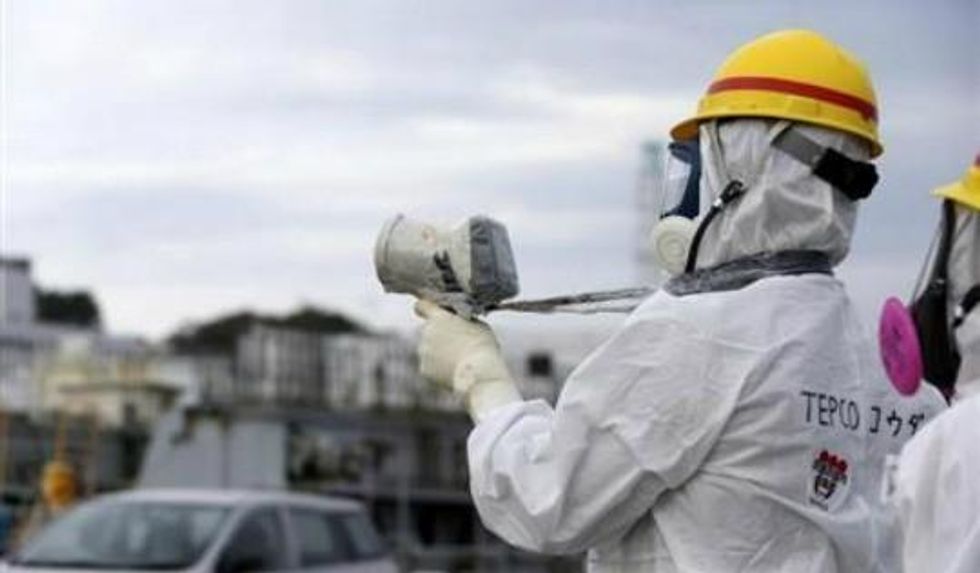Fukushima Evacuation Order Lifted, But Motivations Questioned
Japan looks at long-term plan to re-populate homes near crippled plant as TEPCO continues precarious cleanup

"The decision comes despite sharp divisions among residents over whether or not they should return," reports Agence France-Press, "with many still concerned over the persistent presence of low-level radiation, despite decontamination efforts."
While data varies, The International Commission on Radiological Protection recommends the safest limit of radiation dosage per person per year is one millisievert. In contrast, Japan's governmental guidelines say areas with 20 millisieverts of radiation per year are suitable for human life.
Reporting from Japan's Asahi Shimbun on Monday suggests that one reason the government "is rushing to lift evacuation orders" for the surrounding areas is money. Asahi Shimbun reports:
Tokyo Electric Power Co. (TEPCO), which is being lent money by the government's Nuclear Damage Liability Facilitation Fund to compensate evacuees, is required to continue compensation one year after an evacuation order is lifted. Lifting the orders will hasten the end of those payments.
The monthly payment of 100,000 yen ($980) for "emotional distress caused by the accident" will end for residents who return to their homes. Compensation for property damage and job-loss related to the disaster will continue regardless.
Roughly $14.63 billion has so far been paid in compensation to evacuees from the eleven evacuated municipalities, Asahi Shimbun reports.
The announcement comes as TEPCO continues the precarious task of decommissioning the plant, which has been riddled with radiation leaks, groundwater contamination, and electrical failures.
Last week highly radioactive water overflowed into the ground from a storage tank at the plant, in what officials said was the largest contamination in roughly six months.
______________________
An Urgent Message From Our Co-Founder
Dear Common Dreams reader, The U.S. is on a fast track to authoritarianism like nothing I've ever seen. Meanwhile, corporate news outlets are utterly capitulating to Trump, twisting their coverage to avoid drawing his ire while lining up to stuff cash in his pockets. That's why I believe that Common Dreams is doing the best and most consequential reporting that we've ever done. Our small but mighty team is a progressive reporting powerhouse, covering the news every day that the corporate media never will. Our mission has always been simple: To inform. To inspire. And to ignite change for the common good. Now here's the key piece that I want all our readers to understand: None of this would be possible without your financial support. That's not just some fundraising cliche. It's the absolute and literal truth. We don't accept corporate advertising and never will. We don't have a paywall because we don't think people should be blocked from critical news based on their ability to pay. Everything we do is funded by the donations of readers like you. Will you donate now to help power the nonprofit, independent reporting of Common Dreams? Thank you for being a vital member of our community. Together, we can keep independent journalism alive when it’s needed most. - Craig Brown, Co-founder |
Jacob Chamberlain is a former staff writer for Common Dreams. He is the author of Migrant Justice in the Age of Removal. His website is www.jacobpchamberlain.com.

"The decision comes despite sharp divisions among residents over whether or not they should return," reports Agence France-Press, "with many still concerned over the persistent presence of low-level radiation, despite decontamination efforts."
While data varies, The International Commission on Radiological Protection recommends the safest limit of radiation dosage per person per year is one millisievert. In contrast, Japan's governmental guidelines say areas with 20 millisieverts of radiation per year are suitable for human life.
Reporting from Japan's Asahi Shimbun on Monday suggests that one reason the government "is rushing to lift evacuation orders" for the surrounding areas is money. Asahi Shimbun reports:
Tokyo Electric Power Co. (TEPCO), which is being lent money by the government's Nuclear Damage Liability Facilitation Fund to compensate evacuees, is required to continue compensation one year after an evacuation order is lifted. Lifting the orders will hasten the end of those payments.
The monthly payment of 100,000 yen ($980) for "emotional distress caused by the accident" will end for residents who return to their homes. Compensation for property damage and job-loss related to the disaster will continue regardless.
Roughly $14.63 billion has so far been paid in compensation to evacuees from the eleven evacuated municipalities, Asahi Shimbun reports.
The announcement comes as TEPCO continues the precarious task of decommissioning the plant, which has been riddled with radiation leaks, groundwater contamination, and electrical failures.
Last week highly radioactive water overflowed into the ground from a storage tank at the plant, in what officials said was the largest contamination in roughly six months.
______________________
Jacob Chamberlain is a former staff writer for Common Dreams. He is the author of Migrant Justice in the Age of Removal. His website is www.jacobpchamberlain.com.

"The decision comes despite sharp divisions among residents over whether or not they should return," reports Agence France-Press, "with many still concerned over the persistent presence of low-level radiation, despite decontamination efforts."
While data varies, The International Commission on Radiological Protection recommends the safest limit of radiation dosage per person per year is one millisievert. In contrast, Japan's governmental guidelines say areas with 20 millisieverts of radiation per year are suitable for human life.
Reporting from Japan's Asahi Shimbun on Monday suggests that one reason the government "is rushing to lift evacuation orders" for the surrounding areas is money. Asahi Shimbun reports:
Tokyo Electric Power Co. (TEPCO), which is being lent money by the government's Nuclear Damage Liability Facilitation Fund to compensate evacuees, is required to continue compensation one year after an evacuation order is lifted. Lifting the orders will hasten the end of those payments.
The monthly payment of 100,000 yen ($980) for "emotional distress caused by the accident" will end for residents who return to their homes. Compensation for property damage and job-loss related to the disaster will continue regardless.
Roughly $14.63 billion has so far been paid in compensation to evacuees from the eleven evacuated municipalities, Asahi Shimbun reports.
The announcement comes as TEPCO continues the precarious task of decommissioning the plant, which has been riddled with radiation leaks, groundwater contamination, and electrical failures.
Last week highly radioactive water overflowed into the ground from a storage tank at the plant, in what officials said was the largest contamination in roughly six months.
______________________

